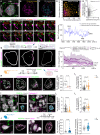Oligodendrocyte precursor cells facilitate neuronal lysosome release
- PMID: 39885146
- PMCID: PMC11782495
- DOI: 10.1038/s41467-025-56484-8
Oligodendrocyte precursor cells facilitate neuronal lysosome release
Abstract
Oligodendrocyte precursor cells (OPCs) shape brain function through many non-canonical regulatory mechanisms beyond myelination. Here we show that OPCs form contacts with their processes on neuronal somata in a neuronal activity-dependent manner. These contacts facilitate exocytosis of neuronal lysosomes. A reduction in the number or branching of OPCs reduces these contacts, which is associated with lysosome accumulation and altered metabolism in neurons and more senescent neurons with age. A similar reduction in OPC branching and neuronal lysosome accumulation is seen in an early-stage mouse model of Alzheimer's disease. Our findings have implications for the prevention of age-related pathologies and the treatment of neurodegenerative diseases.
© 2025. The Author(s).
Conflict of interest statement
Competing interests: The authors declare no competing interests.
Figures



References
-
- Bergles, D. E., Roberts, J. D., Somogyi, P. & Jahr, C. E. Glutamatergic synapses on oligodendrocyte precursor cells in the hippocampus. Nature405, 187–191 (2000). - PubMed
-
- Lin, S. C. & Bergles, D. E. Synaptic signaling between GABAergic interneurons and oligodendrocyte precursor cells in the hippocampus. Nat. Neurosci.7, 24–32 (2004). - PubMed
MeSH terms
Grants and funding
- BA 8014/1-1/Deutsche Forschungsgemeinschaft (German Research Foundation)
- SFB1158/Deutsche Forschungsgemeinschaft (German Research Foundation)
- SPP 1757/Deutsche Forschungsgemeinschaft (German Research Foundation)
- HOMFORexzellent2018/Universität des Saarlandes (Saarland University)
- NanoBioMed Young Investigator grant 2021/Universität des Saarlandes (Saarland University)
- GradUS global2019 and 2020/Universität des Saarlandes (Saarland University)
- Mini-proposal of SFB1027/Universität des Saarlandes (Saarland University)
- HOMFORexzellent2020/Universität des Saarlandes (Saarland University)
- NanoBioMed Young Investigator grant 2020/Universität des Saarlandes (Saarland University)
- H2020-MSCA-ITN EU-GliaPhD/European Commission (EC)
LinkOut - more resources
Full Text Sources
Molecular Biology Databases

